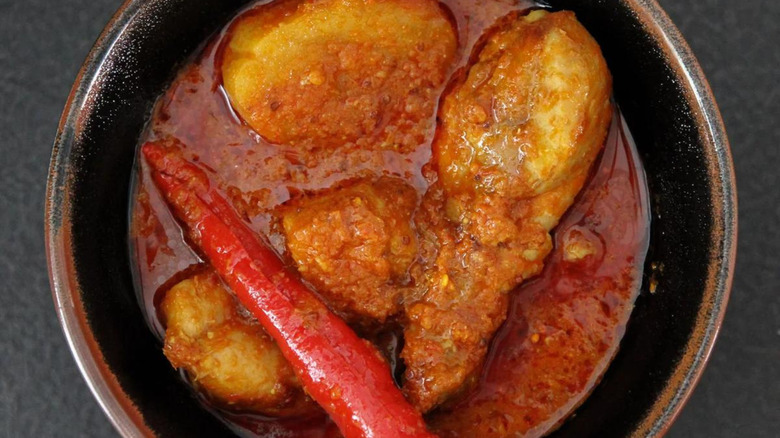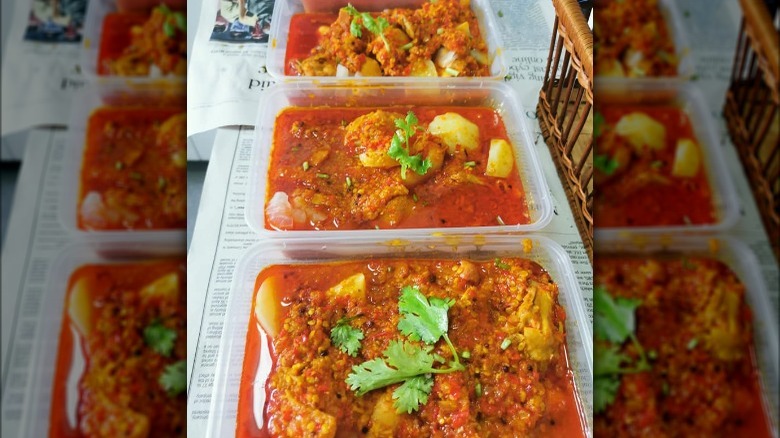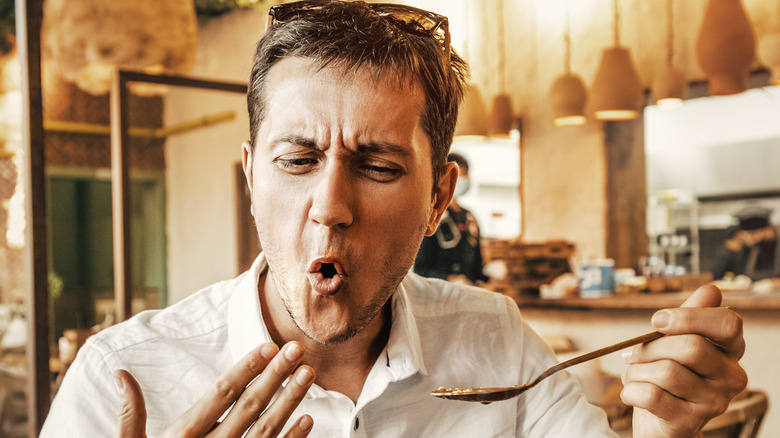Is The Devil's Curry As Spicy As It Is Named?
The culinary jury's verdict on the Kristang community's Debal Curry (popularly known as the Devil's Curry) is out: It is really, really spicy but in the right way. The curry is "forbidding" but it "burns in the right places," according to the BBC. The dish has a lovable "red-hot chili taste," per The Straits Times.
This curry is one of the identity markers of the Kristang community, a group of Portuguese descent in Peninsular Malaysia's southwest coast's Malacca (via Atlas Obscura). Debal in the community's language means leftovers.
The curry has a soupy consistency driven by the zing offered by the vinegar and is a marriage of Malaysian and Portuguese flavors (with Indian and Chinese influences). The dish was originally made with pork and lots of basic vegetables like potatoes and onions. However, the meat has been replaced by chicken owing to Malaysia's Halal rules — pork is a no-no in nations where Islam is the official religion.
Devil's Curry is a tradition
Debal Curry was a Christmas tradition for the Kristang community that is said to have arrived from Portugal to Malacca in the 16th Century, according to BBC. Malacca was a cosmopolitan hub even then, serving as an intersection for Arab and Indian traders (via World Ocean Review).
Surprisingly, the dish was initially not infused with chili — which is now an emblematic element in the dish. The Portuguese were averse to chili, but it is their interactions with Malay communities and the alleged inter-marriages that lent the dish its flavor.
This cultural infusion makes Debal Curry a truly Eurasian dish. It is now found in restaurants around the Malacca region and its recipes are widely shared on cooking blogs across the world. However, the Kristang cuisine is fading, according to Lifestyle Asia. Many chefs have called for urgently preserving this cuisine that has acted as a crossroads for cultures for five centuries.
How to make the fiery curry
To make this rich curry, start with chicken or spare pork ribs. For the spice mix, The Straits Times recommends grinding fresh red chilies, dried chilies, ginger, a small portion of fresh turmeric root, large onions, mustard seeds, and galangal. For the sauce, you will need a few tablespoons of white vinegar, a similar quantity of tomato ketchup, sugar, mustard powder, English mustard, soy sauce, salt, and water. The spice mix and the sauce have to be collated into a paste, according to Rasa Malaysia.
Next, heat up the oil, add mustard seeds and allow them to pop. Add the paste and fry till it releases an aroma and the oil separates. Add your meat and potatoes and let them cook. Balance your curry with salt and sugar and bring it to a boil. Then, let it simmer for 30 minutes. You may also add a dash of tamarind juice, which Rasa Malaysia recommends for an extra tangy flavor. Serve it with steamed rice and get ready for a hit of spice.
How spicy is it really
Like we said in the beginning, this curry can get really fiery. For a really rich spice mix, The Straits Times recommends that you grind 10 fresh red chilies and 10 dried chilies. In America, you would probably use the cayenne pepper since it is commonly available in markets. This chili has a Scoville score of 30,000 to 50,000 units (via Alimentarium). That is hotter than at least seven chilies in the market.
The Devil's Curry also wins when pitched against its cousins, Kapitan Chicken, and lamb or chicken vindaloo. The Kapitan Chicken is similar to Devil's Curry, according to Taste of Asian Food. However, it is toned down and has an elaborate flavor of kaffir lime leaves and belacan shrimp paste.
The lamb or chicken vindaloo — commonly found in Goa which was ruled by the Portuguese till the mid-20th Century — has the flavors of vinegar, dried chilies, and mustard seeds, just like Devils' chicken. However, they do not use 20 chilies in one dish.
If you're a fan of spice, you will surely enjoy this curry, plus, you can taste multiple cultures in a bite and its spiciness may also benefit your health in some ways.



